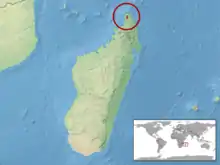| Furcifer timoni | |
|---|---|
 | |
| Male holotype of Furcifer timoni | |
| Scientific classification | |
| Domain: | Eukaryota |
| Kingdom: | Animalia |
| Phylum: | Chordata |
| Class: | Reptilia |
| Order: | Squamata |
| Suborder: | Iguania |
| Family: | Chamaeleonidae |
| Genus: | Furcifer |
| Species: | F. timoni |
| Binomial name | |
| Furcifer timoni | |
 | |
Furcifer timoni is a species of chameleon, a lizard in the family Chamaeleonidae. The species is endemic to Madagascar.
Etymology
The specific name, timoni, is in honor of Timon Robert Glaw (born 2004), who is the son of German herpetologist Frank Glaw, senior author of this species.[2]
Geographic range and habitat
Furcifer timoni is endemic to the Montagne d'Ambre National Park (Amber Mountain National Park) near the northern tip of Madagascar.[3][4] Its geographic range probably extends to 385 square kilometres (149 square miles) at a height of between 750 and 900 metres (2,460 and 2,950 feet) above sea level.[4] Based on some photographic records, it may also be found in the Marojejy National Park (Marojejy Massif), although this fact has not been confirmed.[1] Its preferred natural habitat is forest.[5]
Conservation status
Furcifer timoni has been ranked by the International Union for Conservation of Nature (IUCN) to be Near Threatened,[6] and it is one of several species of chameleon discovered since 1999.[7] It has been listed by the IUCN as Near Threatened because there is a possible threat which may affect the species. If the threat were to become active, Furcifer timoni would not become Critically Endangered. Instead, as it has a range of 385 square kilometres (149 square miles) in one place, it would be able to be classified as endangered.[5] There are also threats of logging for charcoal and the collection of rosewood.[5]
Description

Female specimens of F. timoni have a base colour of green, and a yellow-orange underside. The body is covered in blue spots, and the top of the head is red with blue spots.[7] The head of males of the species is green with purplish spots.[8]
Reproduction
Furcifer timoni is oviparous. Female specimens have been found with up to 14 eggs.[5]
Taxonomy
Furcifer timoni was initially described as a new species in 2009 by German herpetologists Frank Glaw, Jörn Köhler, and Miguel Vences.[3]
References
- 1 2 Jenkins, R.K.B.; Andreone, F.; Andriamazava, A.; Anjeriniaina, M.; Brady, L.; Glaw, F.; Griffiths, R.A.; Rabibisoa, N.; Rakotomalala, D.; Randrianantoandro, J.C.; Randrianiriana, J.; Randrianizahana , H.; Ratsoavina, F.; Robsomanitrandrasana, E. (2011). "Furcifer timoni". IUCN Red List of Threatened Species. 2011: e.T193484A8862420. doi:10.2305/IUCN.UK.2011-2.RLTS.T193484A8862420.en. Retrieved 12 November 2021.
- ↑ Beolens, Bo; Watkins, Michael; Grayson, Michael (2011). The Eponym Dictionary of Reptiles. Baltimore: Johns Hopkins University Press. xiii + 296 pp. ISBN 978-1-4214-0135-5. (Furcifer timoni, p. 266).
- 1 2 "Furcifer timoni | The Reptile Database". Reptile-database.reptarium.cz. 25 February 2007. Retrieved 12 November 2012.
- 1 2 "Furcifer timoni - Overview - Encyclopedia of Life". Eol.org. Retrieved 12 November 2012.
- 1 2 3 4 Jenkins RKB et al. (14 authors) (2011). "Furcifer timoni ". IUCN Red List of Threatened Species. 2011. Retrieved 12 November 2012.
{{cite journal}}: CS1 maint: numeric names: authors list (link) - ↑ "Furcifer videos, photos and facts - Furcifer timoni ". ARKive. Archived from the original on 2011-12-11. Retrieved 12 November 2012.
- 1 2 "A decade of new species discovered in Madagascar - in pictures (9/17)". Guardian. 6 June 2011. Retrieved 12 November 2012.
- ↑ "A decade of new species discovered in Madagascar - in pictures (10/17)". Guardian. 6 June 2011. Retrieved 12 November 2012.
